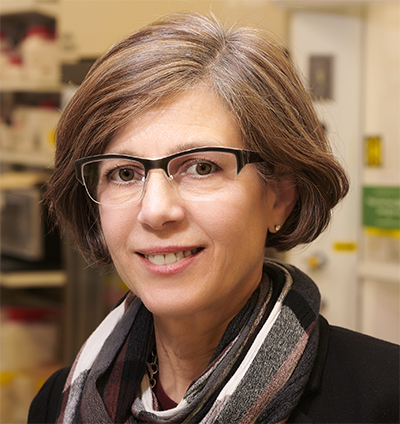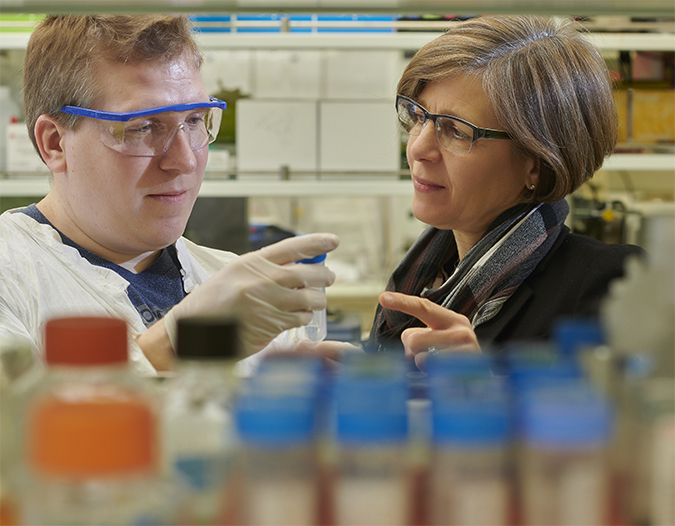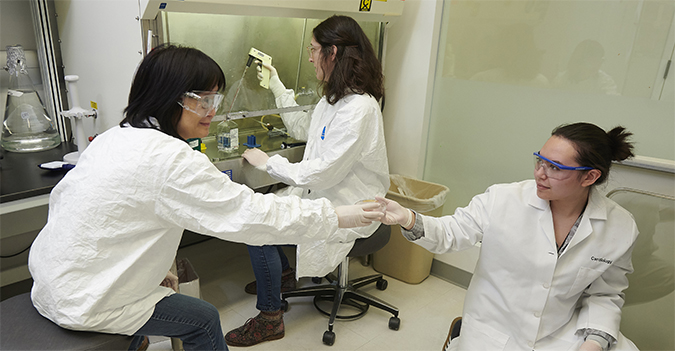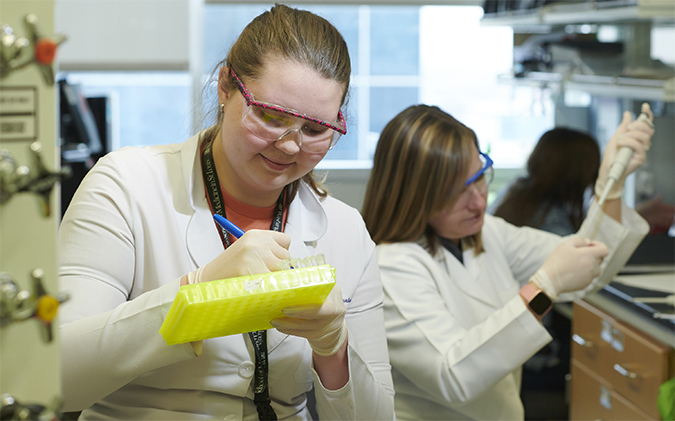Meet Jean Schaffer
Cardiologist realized early that she wanted to pursue research. She was an undergraduate biochemistry major at Harvard University, working with molecular biologist .
“That experience told me I wanted research to be a central focus of my career,” Schaffer said. “But I also knew I wanted to study human disease.”
 Jean Schaffer, director of the Diabetes Research Center at Washington University at St. Louis, is also an associate editor of the Journal of Lipid Research.tim parker/tim parker photography
Jean Schaffer, director of the Diabetes Research Center at Washington University at St. Louis, is also an associate editor of the Journal of Lipid Research.tim parker/tim parker photography
She opted for medical school and completed a residency in medicine and a fellowship in cardiology before returning to the lab as a postdoctoral fellow with cell biologist at the Massachusetts Institute of Technology.
The two aspects of her training progressed in parallel, Schaffer said. “I began to see relationships between what I was studying in the laboratory, which was very interesting at a basic biological level, and fundamental questions about the kinds of pathophysiology that we commonly see in the clinic.”
Schaffer began her own program of investigation when she took a job as an assistant professor at the Washington University School of Medicine in St. Louis. She since has become a full professor and director of the university’s Diabetes Research Center. Her lab seeks to understand the molecular basis of diabetes complications including heart failure. The research focuses on lipotoxicity, which occurs when fatty acid accumulation damages cells and tissues.
Schaffer became an associate editor at the Journal of Lipid Research in 2017. ASBMB Today writer Laurel Oldach caught up with her over the phone about her research and her professional roles. This interview has been condensed and edited.
How did you start working on the molecular mechanisms linking metabolic stress and cardiovascular disease?
I began studying fatty acid transport as a postdoc in the Lodish lab. I was very interested in testing the hypothesis that specific proteins regulate fatty acid import into tissues, given both the importance of this metabolic substrate and the potential toxicity of lipid overload. I used an expression cloning strategy to identify the first fatty acid transport protein and long-chain acyl CoA synthetase 1 as key regulators of fatty acid transport.
As I studied these molecules, I observed that overexpression of these proteins in the heart in a mouse model led to excessive lipid uptake that resulted in cell death, tissue damage and heart failure. And I was struck by the parallels with the heart disease that I treated in my patients with diabetes. This led me to pursue my current interests in metabolic stress responses and diabetes complications.  Jean Schaffer (right) with staff scientist Robert Crowder, who works in her lab at Washington University at St. Louis.Tim parker/tim parker photography
Jean Schaffer (right) with staff scientist Robert Crowder, who works in her lab at Washington University at St. Louis.Tim parker/tim parker photography
Broadly, how can diabetes lead to heart disease?
Dysregulation of both glucose and fatty acid metabolism in diabetes leads to excess delivery of metabolic substrates to tissues throughout the body. One way that cells in different organs compensate initially is by upregulating metabolic pathways to dispose of these substrates.
Excess glucose increases flux through pathways that can contribute to hyperglycemia-induced oxidative stress, and enhanced oxidative metabolism of both glucose and fatty acids at the level of the mitochondria produces reactive oxygen species. So both of these metabolites clearly can cause problems for tissues.
Another way tissues respond to the excess fatty acid supply is to sequester that lipid in cellular triglyceride stores. We found that this initially helps protect against lipotoxicity, but the storage function is limited in non-adipose tissues, and triglycerides can eventually be hydrolyzed to release free fatty acids.
Metabolite-induced oxidative stress damages the endothelium, and it can also cause dysfunction of monocytes, macrophages and foam cells. So in these ways, the abnormal substrate environment of diabetes can lead to initiation and progression of atherosclerosis. But I think it’s important to also remember that there are direct untoward effects of hyperglycemia and hyperlipidemia on the cardiac myocytes themselves that contribute to heart failure.
Some of your recent articles focus on how noncoding RNAs affect mitochondrial function. Tell me about that research.
We wanted to identify novel regulators of lipid-induced cell death, or lipotoxicity, so we used a cell culture model of lipotoxicity and carried out a genetic screen. Through this effort, my lab discovered that small nucleolar RNAs, or snoRNAs, encoded within the introns of the ribosomal protein L13A gene are critical for lipotoxic cell death.
For a long time, we’ve known that snoRNAs form ribonucleoprotein particles that reside in the nucleus and direct epigenetic modifications on newly synthesized ribosomal RNAs. But a new role for snoRNAs in metabolic stress really intrigued us. We discovered that disruption of the gene that hosted these snoRNAs conferred resistance to lipotoxicity, and our screen showed that disruption of proteins involved in snoRNA biogenesis and trafficking also led to resistance. That suggested to us that we had identified several components of an important metabolic stress pathway.
As we further studied these snoRNAs, an important step was to confirm we had the right gene identifications. It’s important to show that that the knockout phenotype can be complemented by restoring the disrupted genetic elements. In this case, the Rpl13a locus encodes four snoRNAs and the RpL13a protein. We found that genetic complementation only occurred when the snoRNAs were restored.
What research questions or directions are most exciting for you right now?
Obviously, we’re interested in the physiological function of these snoRNAs. Our studies suggest that they may have important roles in regulating metabolism. Mice with loss of the Rpl13a snoRNAs have evidence of metabolism that is uncoupled at the level of mitochondria, and this alteration is likely to have important effects on whole-body metabolic efficiency. That’s an area we are excited to pursue.
Another really important direction for us is to determine whether loss of the Rpl13a snoRNAs actually protects against lipotoxicity in vivo in diabetes complications — which was the motivation for originally pursuing these studies.
There are about 400 well-characterized snoRNAs throughout the human genome. There’s an intriguing possibility that other snoRNAs could have noncanonical functions that impact cellular metabolism. That’s an area for future studies.  Jessie Zhang, McKenna Feltes and Sammy Moores (left to right) work together in the Schaffer lab’s tissue culture room.Tim Parker/Tim Parker Photography
Jessie Zhang, McKenna Feltes and Sammy Moores (left to right) work together in the Schaffer lab’s tissue culture room.Tim Parker/Tim Parker Photography
You spent a long time in Boston. Was it a big move to go out to St. Louis?
Yes. I spent a good number of years getting educated and trained in Boston. But as I embarked upon my independent career, I looked for an environment with a critical mass of outstanding investigators studying metabolism and diabetes. Washington University has a long and rich tradition of contributions to metabolism science. It is also an incredibly supportive institution for career development for physician-scientists. It seemed like the right place.
In addition to running your lab, you also direct the Diabetes Research Center at Washington University. Do running a center and heading a lab inform each other in any way?
These two roles actually involve many of the same skills. One needs to be always looking for new opportunities: new science to pursue, new faculty to recruit, new areas for development of a center to provide resources for the research community. Learning how to listen to others and how to build consensus, how to make decisions, and how to engage others to pursue common goals — these are important skills both in the laboratory and for leading a research center. You really need to strike a proper balance.  Members of the Schaffer lab enjoy a lunch outing.courtesy of jean schaffer
Members of the Schaffer lab enjoy a lunch outing.courtesy of jean schaffer
How did you first get involved with the Journal of Lipid Research?
I published my first paper in the JLR, in 1999. This journal reaches a broad audience with interest in many different aspects of lipid metabolism and physiology, so it’s a great place to showcase our work. Along the way, I’ve been asked to review many papers. I suppose because I was diligent as a reviewer and turned my reviews in on time, I was rewarded with being asked to serve as an associate editor.
What do you like to do when you’re not thinking about snoRNAs, metabolism and diabetes?
My passions outside the lab are family and music. My husband is also a scientist, and together we raised our two children during the early stages of our careers. We benefited immensely from mentors who trusted us to work hard and gave us the flexibility to design our own schedules. I also have a great love for music — I play the piano and attend concerts as much as my schedule allows.
In the end, to be able to spend time with family and music — or whatever else interests the scientist outside of their work — the most important skill for success is good time management.  Sasha Medvedeva (left) and Sarah Gale hard at work in the Schaffer lab.Tim parker/tim parker photography
Sasha Medvedeva (left) and Sarah Gale hard at work in the Schaffer lab.Tim parker/tim parker photography
Enjoy reading ASBMB Today?
Become a member to receive the print edition four times a year and the digital edition weekly.
Learn moreGet the latest from ASBMB Today
Enter your email address, and we’ll send you a weekly email with recent articles, interviews and more.
Latest in People
People highlights or most popular articles

Transforming learning through innovation and collaboration
Neena Grover will receive the William C. Rose Award for Exemplary Contributions to Education at the 2025 ASBMB Annual Meeting, April 12–15 in Chicago.

Guiding grocery carts to shape healthy habits
Robert “Nate” Helsley will receive the Walter A. Shaw Young Investigator in Lipid Research Award at the 2025 ASBMB Annual Meeting, April 12–15 in Chicago.

Leading the charge for gender equity
Nicole Woitowich will receive the ASBMB Emerging Leadership Award at the 2025 ASBMB Annual meeting, April 12–15 in Chicago.

Honors for de la Fuente, Mittag and De La Cruz
César de la Fuente receives the American Society of Microbiology’s Award for Early Career Basic Research. Tanja Mittag and Enrique M. De La Cruz are named fellows by the Biophysical Society.

In memoriam: Horst Schulz
He was a professor emeritus at City College of New York and at the CUNY Graduate Center in Manhattan whose work concentrated on increasing our understanding of mitochondrial fatty acid metabolism and an ASBMB member since 1971.

Computational and biophysical approaches to disordered proteins
Rohit Pappu will receive the 2025 DeLano Award for Computational Biosciences at the ASBMB Annual Meeting, April 12-15 in Chicago.

